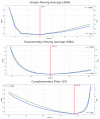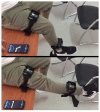Motion Sensors for Knee Angle Recognition in Muscle Rehabilitation Solutions
- PMID: 36236708
- PMCID: PMC9572597
- DOI: 10.3390/s22197605
Motion Sensors for Knee Angle Recognition in Muscle Rehabilitation Solutions
Abstract
The progressive loss of functional capacity due to aging is a serious problem that can compromise human locomotion capacity, requiring the help of an assistant and reducing independence. The NanoStim project aims to develop a system capable of performing treatment with electrostimulation at the patient's home, reducing the number of consultations. The knee angle is one of the essential attributes in this context, helping understand the patient's movement during the treatment session. This article presents a wearable system that recognizes the knee angle through IMU sensors. The hardware chosen for the wearables are low cost, including an ESP32 microcontroller and an MPU-6050 sensor. However, this hardware impairs signal accuracy in the multitasking environment expected in rehabilitation treatment. Three optimization filters with algorithmic complexity O(1) were tested to improve the signal's noise. The complementary filter obtained the best result, presenting an average error of 0.6 degrees and an improvement of 77% in MSE. Furthermore, an interface in the mobile app was developed to respond immediately to the recognized movement. The systems were tested with volunteers in a real environment and could successfully measure the movement performed. In the future, it is planned to use the recognized angle with the electromyography sensor.
Keywords: IMU sensor; algorithmic complexity; knee angle; muscle rehabilitation; wearable system.
Conflict of interest statement
The authors declare no conflict of interest.
Figures















References
-
- World Health Organization . Decade of Healthy Ageing: Baseline Report. World Health Organization; Geneva, Switzerland: 2020.
-
- Franco T., Henriques P.R., Alves P., Varanda Pereira M.J., Pedrosa T., Silva F., Leitão P., Oliveira L. System Architecture for Home Muscle Rehabilitation Treatment; Proceedings of the 10th World Conference on Information Systems and Technologies (WorldCIST’22); Budva, Balkans. 12–14 April 2022; pp. 305–315. - DOI
-
- Lou Z., Wang L., Jiang K., Wei Z., Shen G. Reviews of wearable healthcare systems: Materials, devices and system integration. Mater. Sci. Eng. Rep. 2020;140:100523. doi: 10.1016/j.mser.2019.100523. - DOI
MeSH terms
Grants and funding
- POCI-01-0247-FEDER-045908/European Regional Development Fund (ERDF) through the Operational Programme for Competitiveness and Internationalization (COMPETE 2020)
- UIDB/05757/2020/Fundação para a Ciência e Tecnologia
- UIDB/00319/2020/Fundação para a Ciência e Tecnologia
- 2020.05704.BD/Fundação para a Ciência e Tecnologia
LinkOut - more resources
Full Text Sources

